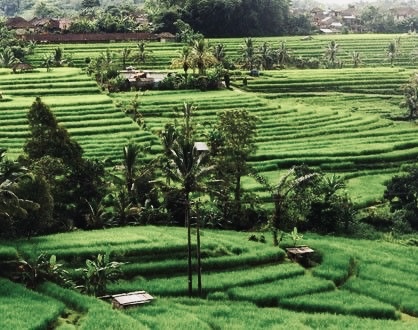
In the west of Bali, nestled among the green hills of the Tabanan region, lie the Jatiluwih rice fields, one of the most breathtaking landscapes on the island. These expansive terraces stretch as far as the eye can see and are not only a visual spectacle but also a living testament to traditional Balinese farming techniques and the subak irrigation system.
Jatiluwih, which means "truly beautiful" in Balinese, lives up to its name. The rice terraces are a UNESCO World Heritage Site, recognized for their cultural and historical value. They are carefully laid out according to the subak system, a complex and ancient irrigation method developed by Balinese farmers. This system, based on the philosophy of Tri Hita Karana (the three causes of well-being: harmony between people, nature, and the spiritual), ensures that water is fairly distributed among the rice fields.
When visitors arrive in Jatiluwih, they are greeted by a panorama of rolling green terraces, with rice plants at various stages of growth. The air is fresh and pure, filled with the scent of wet earth and young rice plants. Small paths wind through the fields, perfect for a peaceful walk or bike ride. As you walk through this green oasis, you hear the gentle sound of flowing water, guided by carefully dug channels to the fields.
The harmony between humans and nature is visible everywhere here. Farmers work in their fields, bent under the sun, planting or harvesting rice using traditional techniques. They wear typical straw hats to protect themselves from the bright sun. All this happens against a backdrop of majestic mountains, including the sacred Mount Batukaru, which watches over the rice fields.
The Jatiluwih rice fields change with the seasons, offering a unique experience for every visitor. In the planting season, the fields are covered with a lush green blanket of young rice plants. By the time the harvest approaches, the terraces turn golden yellow, indicating the rice is ready to be harvested. The beauty of this changing landscape is a true feast for the eyes and offers endless opportunities for photography.
Besides their visual beauty, the Jatiluwih rice fields also hold a deeper spiritual meaning for the local people. The subak system is seen not only as an irrigation method but as a way to maintain harmony between humans and nature. Temples on the edge of the rice fields play a central role in this harmony, where farmers regularly bring offerings to thank the gods for the abundant harvest.
A visit to the Jatiluwih rice fields is a journey through time, to a place where tradition, nature, and spirituality come together. It is an experience that offers not only a beautiful view but also a deeper insight into the unique culture and way of life of Bali.